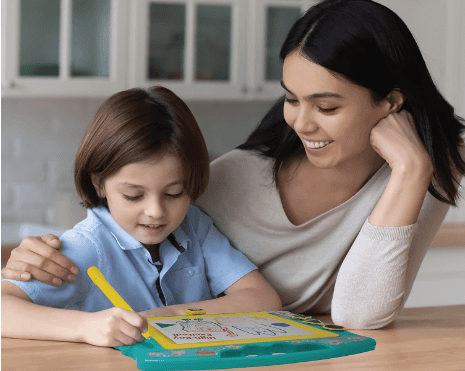Try Any of These 12 Fun Free Games with Your Children

|
Getting your Trinity Audio player ready...
|
In this article, you will find 12 fun free games to play with your child(ren). You probably heard of most of them, but this is a quick reminder. These games allow you to bond and create memories while helping your child practice social skills.
Games are a great way to pass the time and they give your child something to do. Many children behave best when they are kept busy. They also thrive on the positive interactions with you.
All games can be played with more than two players, but for the purposes of this article, each game is discussed in the context of two players (parent and child).
Games Help with Social Skills
The games below allow practice for some or all of the following social skills:
- Waiting Your Turn
- Working Cooperatively
- Paying Attention
- Listening
- Following Directions
- Following the Rules
- Patience
- Counting (although not a social skill, still an important skill)
12 Fun Free Games to Play with Your Child(ren)
1. Hide and Seek
We all know the classic game. One person counts while the other hides. The one who counts has to look for the one who is hiding. Take turns being the hider and the seeker.

2. Bounce the Ball on the Coin
How to Play: Take a large rubber ball and stand across from your child. Place a coin (or any object of choice) in between you and your child. Take turns throwing the ball and trying to make it land on the coin.

3. I am Going on a Picnic
How to Play: In this game the players take turns listing items they will bring on a picnic. Feel free to be as silly as you want. The items must be listed in alphabetical order including all the letters in the alphabet. On the first turn the player says something that starts with A. On the next player’s turn they include what the first player said and then say something that starts with B, and so on.
Here is an example:
Player 1: I am going on a picnic and I am bringing an apple
Player 2. I am going on a picnic and I am bringing an apple and a banana
Player 1: I am going on a picnic and I am bringing an apple, a banana, and a cherry
Keep going until one person forgets an item. Then start again.
Here is the only video clip I could find on how to play the game. I don’t like the pointing at the end but it gives a good description of the rules.
4. Concentration
How to Play: Players go back and forth naming something related to a specific topic. For example, if the topic is girls’ names, you would say a girl’s name on your turn. Players keep going until they run out of names. You can pick any theme you want. If you pick fruit, players keep going until someone can’t think of the name of a fruit. Some other theme ideas include boys’ names, foods, drinks, flowers, states, countries, etc.
Example for Fruit Theme:
Player 1: Grapes
Player 2: Apples
Player 1: Bananas
Player 2: Peaches
and so on…
5. Geography
How to Play: Players take turns naming something related to geography such as a city, state, country, continent, body of water, landmark, etc. When it is your turn you have to name something that starts with the last letter of whatever the last player named.
Here is an example:
Player 1: New York
Player 2: Kentucky
Player 1: Yellowstone National Park
Player 2: Kansas
and so on…
Notice how each place starts with the letter of the last place named.
6. 20 Questions
How to Play: One player thinks of a person or thing. The other player asks 20 yes or no questions to try to guess what the other player is thinking of.
Here is an example:
-Player 1 thinks of Michael Jordan.
-Player 2 asks player 1 up to 20 questions to try to guess what he/she is thinking of.
How to Play: One player thinks of a person or thing. The other player asks 20 yes or no questions to try to guess what the other player is thinking of.
Here is an example:
-Player 1 thinks of Michael Jordan.
-Player 2 asks player 1 up to 20 questions to try to guess what he/she is thinking of.
Sample Questions:
- Is it a person?
- It the person famous?
- Is the person an actor?
- Is the person an athlete?
- Is the person tall?
To make it a little easier, you can name the category ahead of time. For example, player 1 can say, “I am thinking of a person.”
If you take a guess about what the person is thinking of, that also counts as one of the 20 questions.

7. Name that Tune
How to Play: One player plays, hums, or sings a song and the other player has to name the song. Players take turns playing and guessing the songs.
The clip below is the best example I could find. In this clip, one child plays a tune on the piano and the other child tries to guess it. Remember, you don’t need to play an instrument. You can sing the song, hum it, or play the song from a CD/IPOD.
8. Guess What I Drew?
How to Play: One person draws a picture and the other person has to guess what it is. You can do something simple like a car or tree or make it more difficult by drawing a phrase, movie title, etc.
For example, here is a drawing for the title of the famous 1980s movie The Breakfast Club.

9. Draw a Picture Together
How to Play: Create a picture together. Take turns drawing a piece of the picture.
For instance, if you are drawing a person, you draw the eyes, your child can draw the nose, you draw the mouth, etc. See what your joint creation looks like and hang up your team effort.

10. Charades
How to Play: One player acts out the title of a movie, TV show, or book (without talking) and the other player has to guess what it is. You can put your own spin on it and act out whatever you want.
Act out an animal, an emotion, or an object (for example, you can pretend you are a tree in the wind). The other person needs to try to guess what you are doing.
Common Rules:
- First, indicate whether you’re going to act out the title of a movie, book, TV show, etc.
- Next, indicate how many words are in whatever you are acting out by holding up that number of fingers.
- Next, indicate which word you want to start acting out. For example, hold up two fingers for “Second Word.”
11. Simon Says
How to Play: One person is Simon and tells the other player(s) what to do. For example: “Simon says touch your nose,” “Simon says hop like a bunny,” “Simon says touch your toes.” This game could be great for encouraging exercise as well.
When Simon gives a direction but does not say “Simon Says” the other players are not supposed to follow the direction.
Here is a video and song that explains the rules of the game:
12. Find the Hidden Object (Warm or Cold)
How to Play: Pick an object and hide it somewhere in the room. Have your child look for the object.
As your child gets closer to the object tell them they are getting warmer. As they move further away tell them they are getting colder. When your child is right near the object, tell them they are very warm or hot.
Take turns with your child being the hider or finder of the object. Teach them how to tell you when you are getting warmer and colder.
What Are Your Thoughts?
Did you enjoy playing any of these games as a kid or with your kids?
Comment below and let me know or add your own games.
Education and Behavior – A Free Resource to Support Children with Research-Based Strategies and Information. Keeping Parents, Educators, Therapists, and Counselors on the Same Page!






